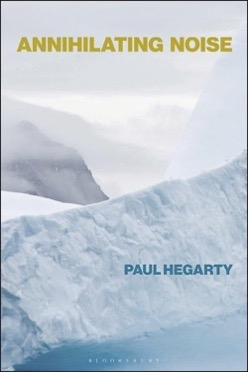Annihilating Noise - Paul Hegarty. New York: Bloomsbury, 2021
by Ramsey Ronalds
Paul Hegarty begins Annihilating Noise with a proclamation: “When noise began (if it did, and, although it did, you missed it), it interrupted” (p. 2). This stylistic imitation of the Book of Genesis’s omniscient narrator is entirely deliberate: noise interrupts and has always done so. But if this is its essential quality, it means it is always an interruption of something. Hegarty moves from poetics to precision to elaborate on this rudimentary dialectic: “Noise is [...] essential, but only if we retain its capacity to be against, to be wrong in some way” (p. 9). The subsequent chapters and collection of essays probe this thesis within the contexts of race, gender, and finance, seeking to uncover the ways in which noise’s interruption and disruption of hitherto stable signifiers can produce visceral and sometimes uncomfortable results. My aim is to focus on the first part of this book, because its function is akin to the eye of a storm. Here Hegarty methodically builds his theory of noise, and while he will go on to traverse a variety of contexts, throwing up a panoply of case studies in dizzying succession along the way, the analyses he subjects them to will be informed by the sets of conclusions he reaches in this initial section.
In Part One, titled “Ungrounding,” Hegarty begins by providing an insightful overview of those “eco-sonic media” practitioners who advocate for a sustained focus on the natural sounds of the world, “free of distraction and disruption” (p. 21). Familiar names appear in this section, such as R. Murray Schafer and his concept of acoustic ecology as well as David Rothenberg, whom Hegarty characterizes as an “extreme variant on the valorization of nature as inherently good” (p. 19). It is clear Hegarty has little sympathy for their cause, however, describing them as “demagogues” and accusing them of predicating their ideas on “problematic bases” such as “returns to lost pasts, on purifying the present, on maintaining tradition and shunning incoming sounds” (p. 20-21). He then goes on to raise a pertinent point during this critical assessment: the role of human technology in making nature audible. Whilst never explicitly mentioned, Hegarty is dealing with the concept of mediation and Schafer and other’s failure to consider human intervention as a necessary prerequisite for re-presenting nature in all its supposed original harmoniousness (p. 31-32).
This discussion of acoustic ecology and its shortcomings allows Hegarty to introduce his own distinct ecology. Rather than treat nature as a benign source of sonic authenticity, he reframes it as a correlative of noise – as a source of excess. Immanuel Kant’s concept of the dynamical sublime is mobilized to help explicate this reframing, and the reader is subsequently treated to iterations of nature as a source of “fear,” “agitation,” and – at its extreme – “death” (p. 23). Crucially, by drawing from Kant, Hegarty manages to resolve the earlier-mentioned problem of mediation by making human sociality an essential component in the production of noise – this component is evidently one he believes the acoustic ecologists have overlooked. Similar to the way Kant’s sublime arises from an initial fear or failure to comprehend a natural event, so too does noise arise as a negation of a set of hitherto stable relations. In both cases the result testifies to an excess that continually resists domestication or stabilization. This argument is then dovetailed with Georges Bataille’s “ecology of total and pointless violence” (p. 24) – an unrelenting materialist outlook that will, by Hegarty’s own admission, go on to permeate the subsequent chapters. A minor criticism here would be the introduction of Bataille’s thought: Hegarty does little to ease the reader into his eclectic style of philosophy, and those who find his relevance too abstract or nebulous may wish to seek out secondary sources for an overview and contextualization of his thought. Hegarty himself has one such contribution, titled Georges Bataille: Core Cultural Theorist (SAGE Publications, 2000).
When Hegarty goes on to discuss noise in the contexts of race, gender, and finance, this fundamental dynamic is almost always reiterated, restated, and recontextualized. It is a subtle irony that a book about noise and its disruptions should have at its core such a stable ecology, but Hegarty stresses numerous times that this stability is all about tracking noise’s amorphous reality. In Part Two, for example, he prefaces his discussion of race by reminding us that noise “hinges on relation, on context” (p. 71), and – after examining ways in which black musicians such as Danger Mouse, Flying Lotus, and Death Grips “collide” and “throw together” a panoply of genres as a way of subverting dominant (white) narratives – he reiterates the dynamic once more: “Noise is not a [...] clearly definable autonomous thing [but] bound up in judgement” (p. 77). The discussion of gender begins with the same again: “Noise is social, cultural, historical, and profoundly contextual” (p. 99).
Whilst the strength of this book undoubtedly lies in the breadth of examples Hegarty draws from (hardly surprising, given that his argument rests on noise’s ineluctable dependence on context), his scope can at times appear too selective. For example, in the chapter on gender, Hegarty focuses on women in avant-garde music, such as contemporary musicians Pharmakon and Puce Mary who have worked to subvert gender hierarchies, but he inexplicably omits the works of genderfluid musicians. Artists such as SOPHIE, Lotic, Yves Tumor, and Arca are all-too-perfect examples of the kinds of disruptive production techniques Hegarty praises (distorted and mangled vocals, frenetic percussion, and bombastic sampling techniques being the most prominently discussed), and their unmistakable subversions of gender binaries and beauty standards would have been a welcome addition alongside the aforementioned musicians. To illustrate this point, one need only refer to Arca’s (Alejandra Ghersi) music video for “Nonbinary” (2020) (as rich in sound design as any of Hegarty’s chosen examples) and watch the barb-clad figure undulating in front of a gnarled scallop shell. It is an unmistakable reference to Sandro Botticelli’s “The Birth of Venus” and a visceral deconstruction of the feminine qualities traditionally exuded by the titular goddess.
Knowing that there are musicians such as these occupying spaces in between traditional narratives, and producing some of the most eclectic and experimental music to date, makes Hegarty’s scope of analysis appear slightly orthodox and limited in retrospect. Having said this, Annihilating Noise is an excellent contribution to sound studies, and should be required reading for anyone interested in the intersection of noise and broader social processes. Hegarty does a good job of summarizing research from contemporary academics such as Marie Thompson and Fred Moten alongside seminal theorists such as Schafer, Rothenberg, Douglas Kahn, and Jean-Yves Bosseur. This, combined with the impressive array of artistic examples, makes for an excellent starting point for those new to the field of sound studies and sound art and for artists looking to supplement their creative practice with theoretical research.


